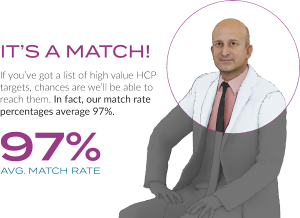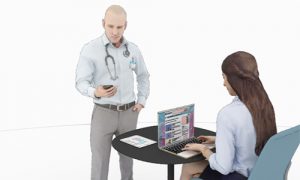5 Ways Healthcare Brands Can Strengthen Relationships with HCPs
One core competency that a company must master to increase market share and establish substantial brand presence is strong customer relationships. For a healthcare brand, it is essential to have strong relationships, not just with the end consumer or the patient, but with the healthcare professional who will be prescribing the treatment. The following article focuses on 5 methods to increase engagements with HPCs online.
Increasing engagement with HCPs online has become exceedingly difficult over the past 5 years. There are many websites and e-newsletters competing for a physician’s attention. HCPs are busy people with a limited amount of time to relegate to researching new treatment options. They suffer from information overload as easily as anyone else.
We tend to think that physicians are only found on endemic health sites, like professional journal sites, EHRs, or association sites. This is simply not true. Physicians are also just as likely to be found on non-endemic health sites. They are on Facebook, Pinterest, CNN, shopping sites, and any other number of non-endemic sites. They have the same needs as everyone else – at the end of their day, they are tired, they want to relax, play on Facebook, catch up on news stories, maybe shop online.
So, how can we get their attention and increase engagement with them?
 1. Using HCP authentication with a list-match strategy will help you find HCPs where they are, not where you assume they will be. For the greatest engagement, you want your ads to appear only to physicians and only on endemic sites that speak to the challenges that physicians face in their specialties.
1. Using HCP authentication with a list-match strategy will help you find HCPs where they are, not where you assume they will be. For the greatest engagement, you want your ads to appear only to physicians and only on endemic sites that speak to the challenges that physicians face in their specialties.
2. However, you can reach the same physicians by expanding your reach using programmatic. You can still use an authentication and list-match strategy within programmatic to be sure that you are reaching the HCPs that you need to reach. Only now you are extending out to other places that HCPs visit frequently. Although, at this point physicians may not be in the same frame of mind as on an endemic site, this less-expensive option is still reaching your HCPs, and raising their brand awareness or peaking their interest if it is an unbranded ad. The one thing here to remember, our minds never turn off and we never turn off work completely.
3. Consider using other forms of advertising besides banner ads. Native advertising is highly effective with higher click through rates than traditional banner ads. Native ads are designed to blend in more with the content on the website – however, they are still clearly delineated as sponsorships.
 4. Become the “tool” for physicians to look good to their patients and make their lives easier. In your advertising, promise information they can use to help them strengthen relationships with their patients. Help HCPs by offering the information they need to explain the treatment options to patients in the easiest way possible. This information can easily be delivered online in video or article formats. PDFs can be created so physicians may print them out in pamphlet or flyer format.
4. Become the “tool” for physicians to look good to their patients and make their lives easier. In your advertising, promise information they can use to help them strengthen relationships with their patients. Help HCPs by offering the information they need to explain the treatment options to patients in the easiest way possible. This information can easily be delivered online in video or article formats. PDFs can be created so physicians may print them out in pamphlet or flyer format.
5. Emotions evoke brand engagement and loyalty. A brand website for a healthcare product should have two sides – one for healthcare providers and one for patients. It is important that these two vantage points are kept separate, because the messages on each site will speak to the audience in different ways. Patients are interested in hearing about success stories, seeing how a drug or device can extend or improve their quality of life. While physicians are interested in the impact from a patient perspective, they are also interested in how the drugs work and how to administer the drug. However, the physician resources should still evoke emotion. This is difficult to accomplish with FDA regulations about what can and cannot be said on a website. Some ideas for this:
a. Images that evoke emotions – here is a website that has an amazing background image that immediately provokes thought: imfinzihcp.com.
b. Videos with HCP testimony – in a recent case study, short videos of leading physicians provided a 20% lift in pageviews and a 30% lift in session duration over a traditional article on a similar topic.
c. Patient Journey videos and/or stories with images of the people.

